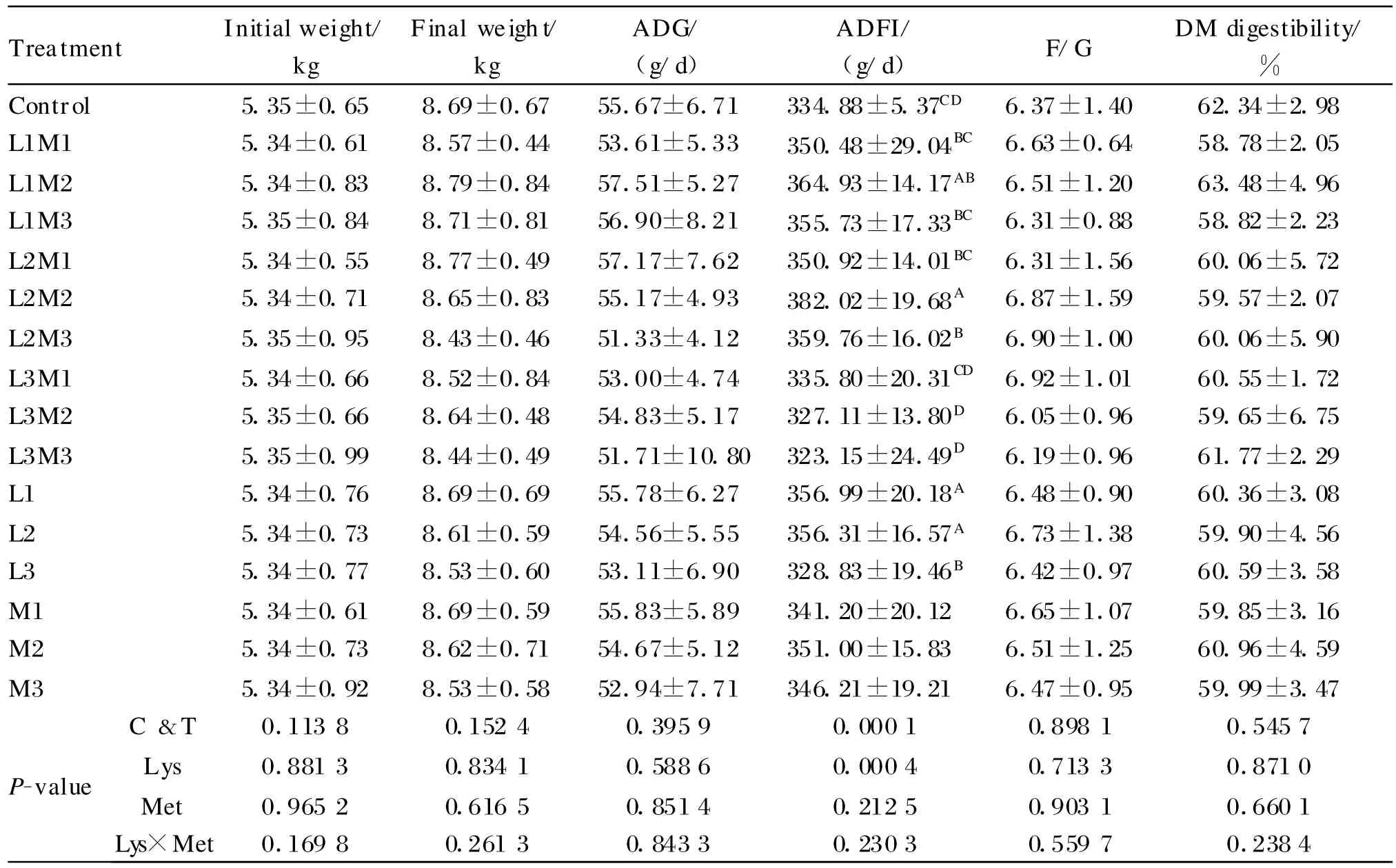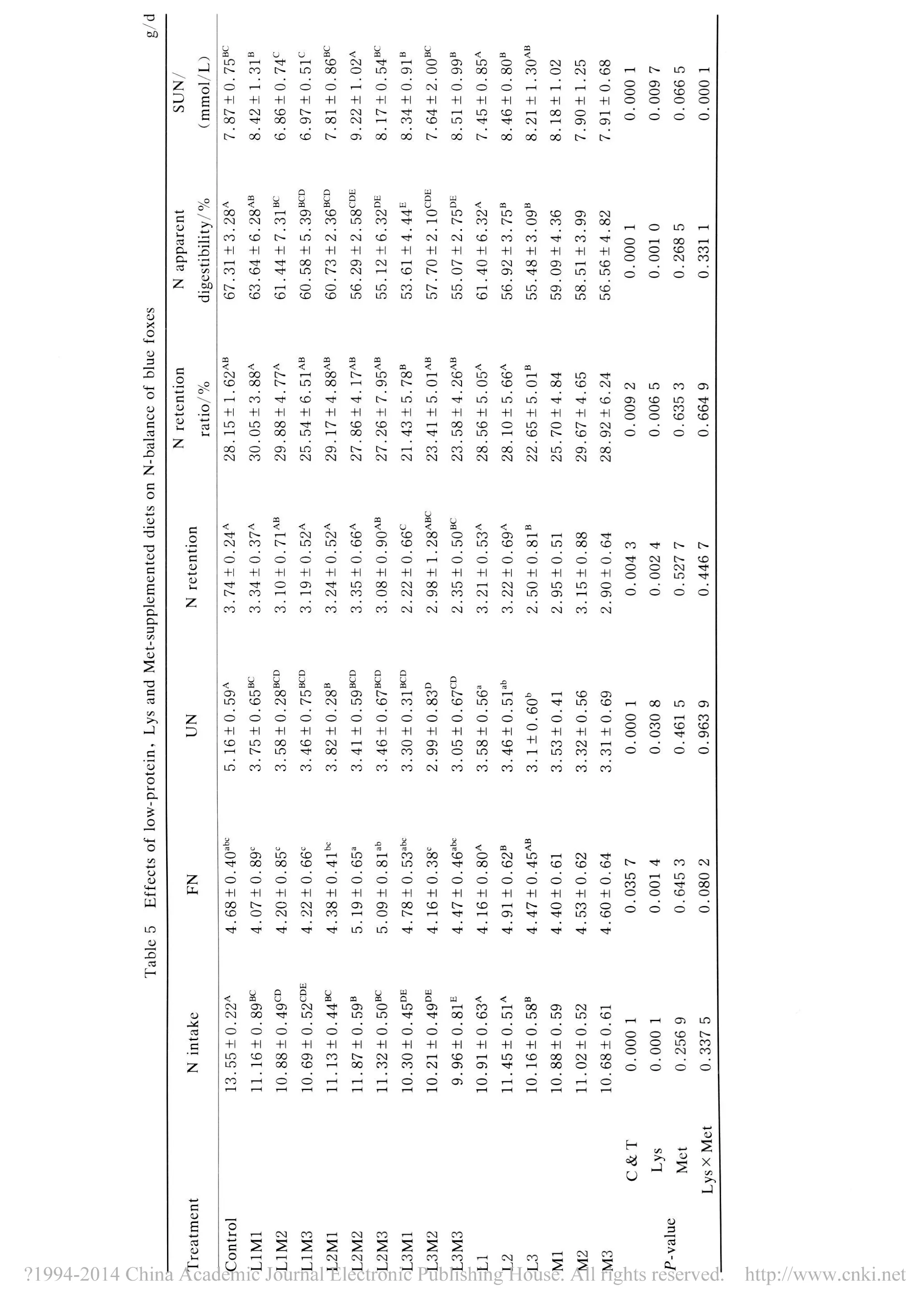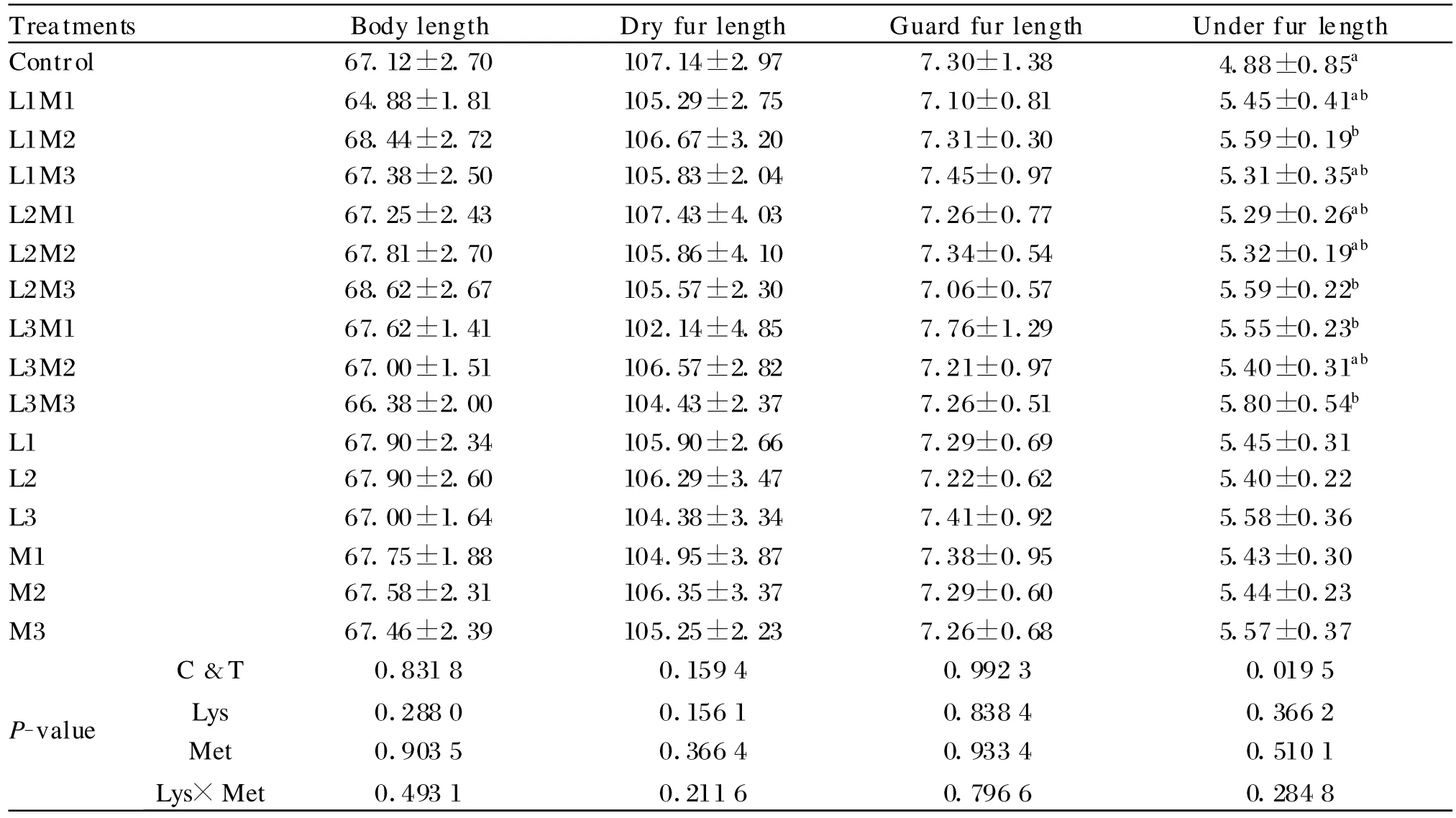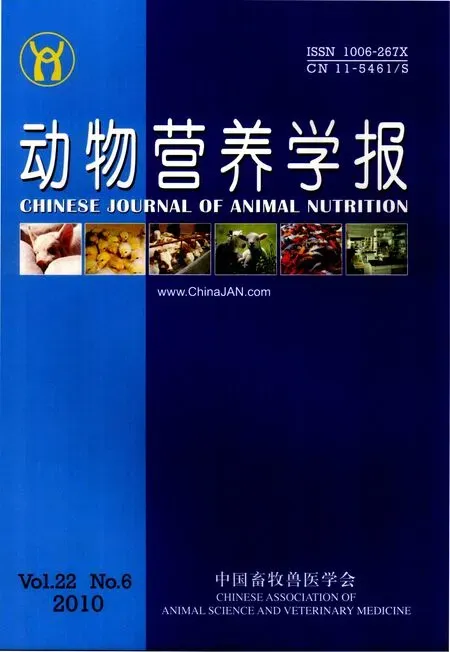低蛋白质饲粮中添加DL-蛋氨酸和赖氨酸对冬毛期蓝狐生产性能、氮平衡及毛皮质量的影响
ZHANG Haihua LI Guangyu LIU Baiyang REN Erjun XING Xiumei YANG Fuhe CHANG Zhongjuan WU Qiong
Blue fox(Alopex lagopus)is by nature a carnivorous species with a high protein requiremen t,and diets used in commercial blue fox production ch aracteristically contain high levels of animal protein.Feed constitutes the greatest individual item of cost,amounting to 50%of the total production costs in fox farming[1].As protein is the most expensive dietary nutrient,any reduction in protein level contributes to a saving in production costs,and moreover,to a reduction in nitrogen emission.In the light of findings in growing-furring silver foxes,Harris et al.[2]concluded that 28%of protein in dry matter(DM)was sufficient for growth as that in higher protein levels.A reduction in protein levels,f rom 45%to 22%of metabolic energy(ME),was reported not to affect body weight.However,a protein level below 28%-30%of ME significantly reduced body length at pelting[3].The established blue fox nutrition requirements do not contain any data on amino acids.In mink,another carnivorous f urbearing animal,researches on dietary protein and amino acids are intensive[4-7].These studies displayed that methionine(Met)was the first limiting amino acid for hair growth and thus for f ur quality,and lysine(Lys)was the second limiting amino acid.There were some experiments which confirmed that animals fed diets of low-protein with some essential amino acid supplementations had no significant differences in their growth perf ormance compared with those fed conventional diets[8].Earlier feeding experiments showed that it was possible to decrease the recommended protein level during the growing-furring season of blue foxes[9-10].The crucial point of this study is to evaluate the growth performance,N balance and fur characteristics of blue foxes fed low-protein diets supplemented with Met and Lys during the growing-furring period,and to quantify the optimal supplementation levels of amino acids in the low-protein diets.
1 MATERIALSAND METHODS
The experiment was carried out at the Fur Animals Experiment Station of Institute of Special Economic Animals and Plants of the Chinese A-cademy of Agricultural Sciences(44°N,126°E)in Northeast China during the period from September 27 to December 13 in 2007.The experimental blue foxes were housed in standard roof ed sheds with open sides in individual standard rearing cages(100 cm×70 cm×70 cm).The animals were exposed to natural temperature and photoperiod.
1.1 Animals and experimental design
One hundred and twenty male blue foxes were selected with similar weight[(5.34±0.57)kg]from different litters in an attempt to minimize genetic variation.The animals were allotted to 10 treatments of 12 animals each and fed twice a day at 08 :00 and 16 :00.Water and experimental diets were provided for ad lib consumption throughout the trial.Before the formal experiment,the animals were accustomed to the experimental feed for two weeks.The design of theexperimental diets was shown in Table 1.Two experimental dietary protein levels added different proportions of Lys and Met became 10 treatments.The blue foxes were raised in cages of standard size(100 cm×80 cm×80 cm).All training and testing of the animals were perf ormed by the same person.Body weights were recorded at monthly intervals.Daily feed consumption of blue foxes was measured by offering a known quantity of feed and weighing residues the next day.The animals were pelted in accordance with common farming practice.Skin length was calculated from tip of nose to base of tail.
Eight blue foxes'blood was collected from heart in vacuum tubes in each group at the end of the trial,and centrifuged at 5 000 r/min for 10 min.Serum separated from blood was packed in Eppendorf centrifuge tubes,and then kept at-20℃until analysis.

Table 1 The design of the experiment(DM basis) %
1.2 Experimental diets
Ten experimental diets were prepared at the same time before the start of the experiment and stored frozen at-20℃in cold storage for later analysis.All diet samples were collected for chemical analyses bef ore f reezing.Diet composition was given in Table 2.Analyzed values of the diets and respective digestibility values were obtained from 17 weeks old male kits in N-balance experiments.
1.3 N-balance experiments
The N-balance experiments were carried out with eight 21-week old male blue foxes from each group.The feces and urine collection period lasted for 3 days(October 14-16,2007).The animals were raised in metabolism cages constructed for separate collection of feces and urine.Feces and urine were collected quantitatively everyday and kept frozen f or later analysis.To avoid ammonia evaporation from the urine and feces,20 mL of 5%sulphuric acid solution was added to the urine collection bottles,and the urine collection trays were sprayed with 20%citric acid solution once everyday.In the N-balance calculations,retained N was determined as ingested N-(fecal N+urinary N).
1.4 Chemical analyses
The chemical compositions of feed and feces were analyzed by standard methods.Dry matter(DM),ash,crude protein(CP),calcium,and phosphorus contents were analyzed according to AOAC procedures[11].Thecalculation of MEcontent and the proportional composition of ME were based on the digestibility coefficients achieved and the following ME values:protein 18.8 MJ/kg,fat 39.8 MJ/kg and carbohydrate 17.6 MJ/kg[12].The concentrations of amino acids were determined on an Agilent 1100 high perf ormance liquid chromatograph(Agilent Technologies,Santa Clara,CA).All chromatographic procedures were perf ormed at room temperature,and the samples and standards were evaluated in duplicates as described by Sedgwick et al.[13].Serum urea nitrogen(SUN)concentration and serum total protein were measured according to the method of Bardford[14]using the kit(Nanjing Jiancheng Biotechnology Co.,Ltd.)as the standard.
1.5 Calculations and statistical analyses
The apparent total tract digestibility(AD)coef ficient of nutrient was calculated as f ollows:AD=(a-b)/a,where a is the intake of nutrient from feed,and b is the nutrient in feces.Statistical analyses of experimental data were performed with the general linear model(GLM)procedure of the SAS statistical package[15].The differences among groups were tested by means of the least significant difference method in the statistical model.

Table 2 Composition of the diets(DM basis) %
2 RESULTS
2.1 Feed intake and growth performance
2.1.1 Average daily feed intake(ADFI)
ADFI was aff ected by dietary protein levels with amino acid supplements,and the values were all significantly higher in the L2M2,L1M2 and L2M3 groups than in the control group(P<0.01,Table 4).The ADFI values were affected by Lys levels(P<0.01),and were higher in L1 and L2 than in L3.There was no Met effect or Met-Lys interaction on the ADFI(P>0.05).

?
2.1.2 Body weight and average daily gain(ADG)
Initial body weight,final body weight and ADG were similar among the groups(P>0.05,Table 4).Different Met and Lys levels did not aff ect the ADG(P>0.05),but the ADG was reduced with dietary Lys increased,and L1M 2 was the highest one.There was no Met-Lys interaction effect on the ADG(P>0.05).
2.1.3 Feed conversion rate(FCR)and digestibility of DM
FCR and DM digestibility were of no significant difference among groups(P>0.05,Table 4).Different levels of Lys,Met and the interaction between Lys and Met had no effects on FCR and DM digestibility(P>0.05).

Table 4 Ef fects of low-protein,Lys and Met-supplemented diets on performance of blue f oxes
2.2 N-balance
2.2.1 N intake
Daily N intake of the control group was signif icantly higher than the other groups(P<0.01,Table 5).N intake was af fected by different levels of Lys(P<0.01),and L2 group was the highest one.Different levels of Met and interaction between Lys and Met did not affect the N intake(P>0.05),and M 2 was the highest one.
2.2.2 Fecal nitrogen(FN)
FN of the control group was higher than most low-protein groups,except for L2M 2,L2M 3 and L3M1(P<0.05).FN was aff ected by different levels of Lys(P<0.05),and L2 and L1 groups were the highest and the lowest,respectively.Dif ferent levels of Met and the interaction between Lys and Met had no effects on FN of different groups(P>0.05,Table 5).

?
2.2.3 Urine nitrogen(UN)
UN of the control group was significantly higher than all low-protein groups(P<0.01),and L3M2 group was the lowest one.Different Lys levels had signif icant effects on UN of each group(P<0.05),and L1 and L2 groups were the highest and the lowest,respectively.There were no significant differences of UN among different levels of Met and the interaction between Lys and Met(P>0.05,Table 5).
2.2.4 N retention
N retention was affected by dietary protein levels with amino acid supplements(P<0.01,Table 5).The Lys levels of L1 and L2 werenotably higher than that of L3(P<0.01).Different Met levels and the interaction between Lys and Met had no significant effects on N retention(P>0.05),and N retention was the highest in the M2 level.
2.2.5 N retention ratio
There were no signif icant dif ferences of N retention ratio among all the treatments(P>0.05,Table 5),but the groups of L1M1 and L2M1 were higher than the control group.Diff erent Lys levels had remarkable ef fects on N retention ratio of each group(P<0.01),and L1 and L2 were significantly higher than L3(P<0.01).Different Met levels and the interaction between Lys and Met had no significant effects on N retention ratio(P>0.05),and M2 was the highest one.
2.2.6 SUN
SUN was significantly higher in L2M2 group than that in the control and the other groups(P<0.01,Table 5).There were significant differences among dif ferent Lys levels(P<0.01),and L1 was the highest one.There were no significant differences among different Met levels(P>0.05).The interaction between Lys and Met had signif icant effects on SUN of each groups(P<0.01).
2.3 Body length and fur characters
No significant differences were observed in body length,dry fur length and guard fur length among the control and the other low-protein groups(P>0.05,Table 6).Different Lys levels,Met levels and the interaction between Lys and Met also had no effects on the three items of different groups(P>0.05).The under f ur length of the control group was significantly lower than some of the low-protein groups(P<0.05).

Table 6 Effects of low-protein,Lys and Met-supplemented diets on f ur characteristics of blue f oxes cm
3 DISCUSSION
3.1 Feed intake and growth performance
Feed intake can be affected by many factors,including animal growth period,feed energy,the balance of amino acids and other nutrients,palatability,ion concentrations in intestines,and feedstuff digestibility and so on.Feed intake of some animals would be reduced if protein in diets was absent[17],and this may induce the synthesis of digestive enzyme being decreased and the body protein being broken down.Chickens and rats can slightly improve their intake to compensate the shortage of amino acids when fed the diets with inadequate amino acids[18].The ADFI of this study was affected by different diets and may be influenced more by dif ferent dietary Lys levels.Our results suggest that supplemental Met could improve the digestibility of low-protein diets for blue foxes,which shows good agreement with Dahlman's results[19].Our results are also consistent with the results reported in swine and poultry that free amino acids are used as ef ficiently as protein-bound ones,and it is therefore possible to obtain the same performance with low-protein,amino acid-supplemented diets as with high-protein controls[20-21].
3.2 N-balance
N intake was decreased with dietary protein level being reduced.It may be related to the increased dietary content of extruded corn.The results were consistent with earlier findings[22-23].According to the experiment,N excretion in urine declined signif icantly(P<0.01)when the protein level in the diet was lowered from 27%to 19%(Table 5).The results were consistent with the earlier findings that N excretion declined noticeably along with a reduction in dietary protein in pigs[24].N retention and N retention ratio were not significantly different among most groups.Our results showed very good agreement with the view that the lower the protein level in the diet,the better the utilization of N and the smaller the proportion excreted.A previous study showed that in 21-week-old blue foxes,N retention did not dif fer in relation to dietary protein level and even 15%of protein was suff icient to satisf y the animals' requirement[19].The protein requirement of blue f oxes at this age is likely to be determined mainly by hair growth,suggested by studies of Blomstedt[25-26]and also by recent studies in mink[27].SUN of L2M2 was the highest,9.22 g/d,which was significantly higher than that in other groups(P<0.01).Malmolf[28]reported that SUN concentration was related to the status of protein metabolism and the balance of amino acids in the animal,and it decreased when amino acids were well balanced[29].Our results showed th at when the dietary protein level decreased from 27%to 19%with Met and Lys supplements,the performance of blue foxes was not aff ected,but the N excretion was decreased.This discovery was confirmed by the present research on blue foxes which showed that there was a 36.8%reduction in N excretion when the protein level declined from about 320 to 250 g/kg(DM basis)[19].
3.3 Fur parameters
The development of hair and the quality of fur were crucially af fected by dietary f actors in later growing-f urring period of mink in recent studies[27].In our study,there were no significant differences observed in body length,dry fur length and guard fur length among all groups except for under fur length.The body length of L1M2 and L2M2(68.44 and 68.62 cm,respectively)was higher compared with other groups.In an earlier study of blue foxes,low-protein diets added with Met,Lys,or both,did not af fect fur quality compared with high-protein control group[30].These results were consistent with previous studies that Met supplementation improved the overall fur quality[31]and skin length[9]of blue foxes fed the lowest protein diet,and brought them up to the level of animals in the highest protein diet group.From the result we conclude that sulfur containing amino acids associated with other essential amino acids may be a more important f actor for the development of winter fur during the last months of the growing-furring period,while lysine,correspondingly,the less.
4 CONCLUSIONS
①Compared with the high protein level group,there were no significant effects on growth performance and f ur quality of growingfurring blue f oxes when the protein level of their diets with Lys and Met supplements was reduced from 27%to 19%on DM basis.
②Reducing the percentage of CP in dietary DM by 1 unit,on average,led to a 4.1 percentage unit decline in the daily amount of N excreted in urine.In absolute amounts,an approximately 1.72 g decline in N excretion per blue fox per day can be achieved by reducing the dietary protein level from about 27%to 19%of DM.
③Considering growth performance and f ur quality,the group L1M 2 was the best one.When the dietary protein was decreased to 19%(DM basis),the diet supplemented with 0.6%(DM basis)Met and 0.3%(DM basis)lysine was optimum.The optimal dietary lysine and Met levels to attain the best growth performance and fur characters were 1 035 and 2 070 mg/d,respectively,during growing-furring period.
[1] HERNESNIEMI T.The f ox's nutrient requirements and feeds[C]//HERNESNIEMI T.Ketunkasvatuksen taito.Jyväskylä:Gummerus Kirjapaino,2000:217.
[2] HARRIS L E,BASSETT CF,LLEWELLYN L M,et al.The protein requirement of growing foxes[J].Journal of Nutrition,1951,43:167-180.
[3] RIMESLA˚TTEN H.Experiments in feeding diff erent levels of protein,fat and carbohydrates to blue foxes[R].Ist International Scientif ic Congress in Fur Animal Production.Helsinki:[s.n.],1976.
[4] BØRSTING C,CLAUSEN T.Requirements of essential amino acids for mink in the growing-f urring period[C]//Polish Society of Animal Production.VIth International Scientific Congress in Fur Animal Production.Warsaw:[s.n.],1996:15-24.
[5] DAHLMAN T,NIEMELÄP,KIISKINEN T,et al.Influence of protein quantity and quality on mink[C]//Polish Society of Animal Production.VIth International Science Congress in Fur Animal Production.Warsaw:[s.n.],1996:9-14.
[6] DAM GAARD B.Dietary protein supply to mink(Mustela vison):ef fects on physiological parameters,growth perf ormance and health[D].Ph.D.Thesis.Frederiksberg:The Royal Veterinary and Agricultural University,1997:31.
[7] KERMINEN-HAKKIO M,DAHLMAN T,NIEMELÄP,et al.Eff ect of dietary protein level and quality on growth rate and fur parameters in mink[R].VIIth International Science Congress in Fur Animal Production.Kastoria:[s.n.],2000:7-12.
[8] KERR B J,MCKEITH F K,EASTER R A.Effect of perf ormance and carcass characteristics to finisher pigs f ed reduced crude protein,amino acid-supplemented diets[J].Jounal of Animal Science,1995,73:433-440.
[9] DAHLMAN T,VALAJA J,NIEMELÄP,et al.Influence of protein level and supplementary L-methionine and lysine on growth performance and f ur quality of blue f ox(Alopex lagopus)[J].Acta Agriculture Scandinavica,2002,52:174-182.
[10] KOSKINEN N,DAHMAN T,PÖLÖNEN I,et al.Physiological bases for increasing the productivity of mammals introduced in zooculture seminar[J].Petroleum Science and Technology,2005:107-108.
[11] Association of Off icial Analytical Chemists.Of ficial methods of analysis[M].17th ed.Arlington:[s.n.],2003.
[12] HANSEN N E,FINNE L,SKREDE A,et al.Energy supply f or the mink and the f ox[R].Nordic Association of Agricultural Scientists.NJF Report No.63.Copenhagen:[s.n.],1991.
[13] SEDGWICK G W,THOMPSON JR.Eff ect of protein precipitating agents on the recovery of plasma f ree amino acids[J].Canadian Journal of Animal Science,1991,71:953-957.
[14] BRADFORD M M.A rapid and sensitive method f or the quantitation of microgram quantities of protein utilizing the principal of protein-dye binding[J].Analytical Biochemistry,1976,72:248-254.[15] SAS Institute.SAS/STAT user's guide[CP/CD].4th ed.Cary,NC:SAS Institute Inc.,1989.
[16] WANG J T,GAO Z C.Eff ects of dietary ratio of lysine to arginine on thegrowth performance and nitrogen retention of broilers[J].Chinese Journal of Animal Science,1999,35(3):8-11.(in Chinese)
[17] HAN H J,KONG F C.The study of animal intake adjustment[J].Private Scientif ic and Technological,2007,3:88.
[18] YAN X H.Analysis of the ef fect of ration f actors on intake[EB/OL].[2009-06-01].http://sil-iao.d288.com/xmsl/756178088.html.
[19] DAHLMAN T,KIISKINEN T,MÄKELÄ J,et al.Digestibility and nitrogen utilisation of diets containing protein at different levels and supplemented with DL-methionine,L-methionine and L-lysine in blue fox(Alopex lagopus)[J].Animal Feed Science and Technology,2002,98:219-235.
[20] GRUBER K,ROTH F X,KIRCHGESSNER M.Effect of partial dietary amino acid deductions on growth rate and nitrogen balance in growing chicks[J].Archives Fǜr Geflǜgelkunde,2000,64:244-250.
[21] ROTH F X,GRUBER K,KIRCHGESSNER M.The ideal dietary amino acid pattern f or broilerchicks of age 7 to 28 days[J].Archives of Fǜr Geflǜgelkunde,2001,65:99-206.
[22] JONGBLOED A W,LENIS N P.Alteration of nutrition as a means to reduce environmental pollution by pigs[J].Lives Production Science,1992,31:75-94.
[23] ZHANG H H,LI G Y,YANG F H,et al.Eff ect of diets with low protein supplemented with lys and met on the performance and digestive metabolism of growing blue f ox[J].Chinese Journal of Animal Nutrition,2008,20(6):724-730.(in Chinese)
[24] VALAJA J,ALAVIUHKOLA T,SUOMI K.Reducing crude protein content with supplementation of synthetic lysine and threonine in barley-rapeseed meal-pea diets for growing pigs[J].Agricultural Science Finland,1993,2:117-123.
[25] BLOMSTEDT L.Pelage cycle in blue fox(Alopex lagopus):a comparison between animals born early and late in the season[J].Acta Agriculture Scandinavica,1998,48:122-128.
[26] BLOMSTEDT,L.Pelage development in mink,f erret,and blue f ox,and some influencing f actors[D].Ph.D.Thesis.Helsinki:University of Helsinki,1998.
[27] RASMUSSEN P V,BØRSTING C F.Ef fects of variations in dietary protein levels on hair growth and pelt quality in mink(Mustela vison)[J].Canadian Journal of Animal Science,2001,80:633-642.
[28] MALMOLF K.Amino acid in farm animal nutrition metabolism,partition and consequences of imbalance[J].Journal of Agricultural,1998,18:191-193.
[29] HOLECEK M.Relation between glutamine,branched-chain amino acids,and protein metabolism[J].Nutrition,2002,18:130-133.
[30] TYÖPPÖNEN J,BERG H,VALTONEN M.Ef fects of dietary supplement of methionine and lysine on parameters and fur quality in blue fox during low-protein feeding[J].Agricultural Science Finland,1987,59:355-360.
[31] DAHLMAN T,VALAJA J,JALAVA T,et al.Growth and f ur characteristics of bluefoxes(Alopex lagopus)fed diets with dif ferent protein levels and with or without DL-methionine supplementation in the growing-f urring period[J].Canadian Journal of Animal Science,2003,83(2):239-245.

